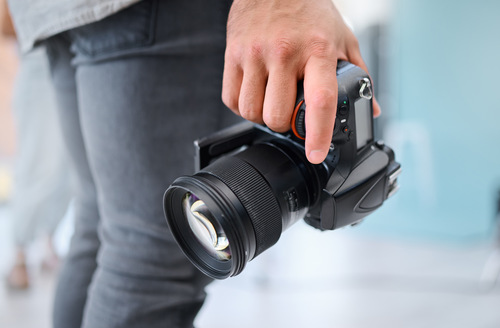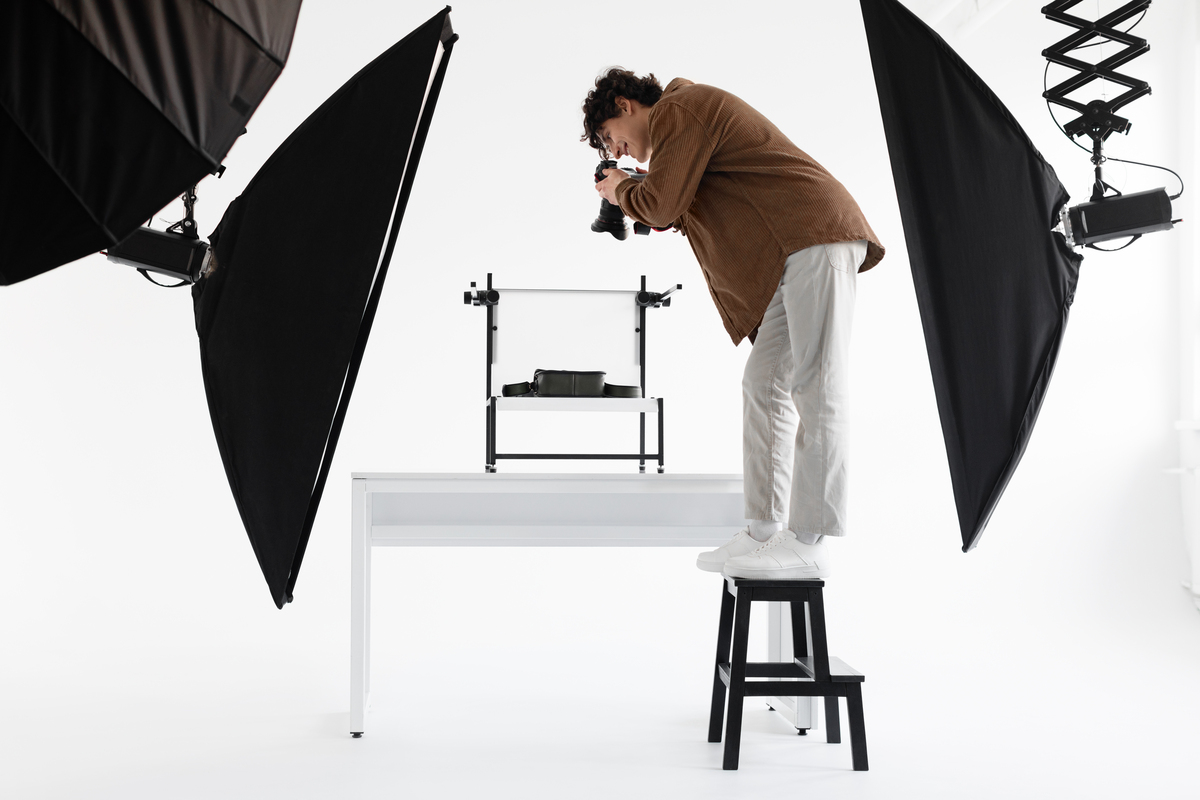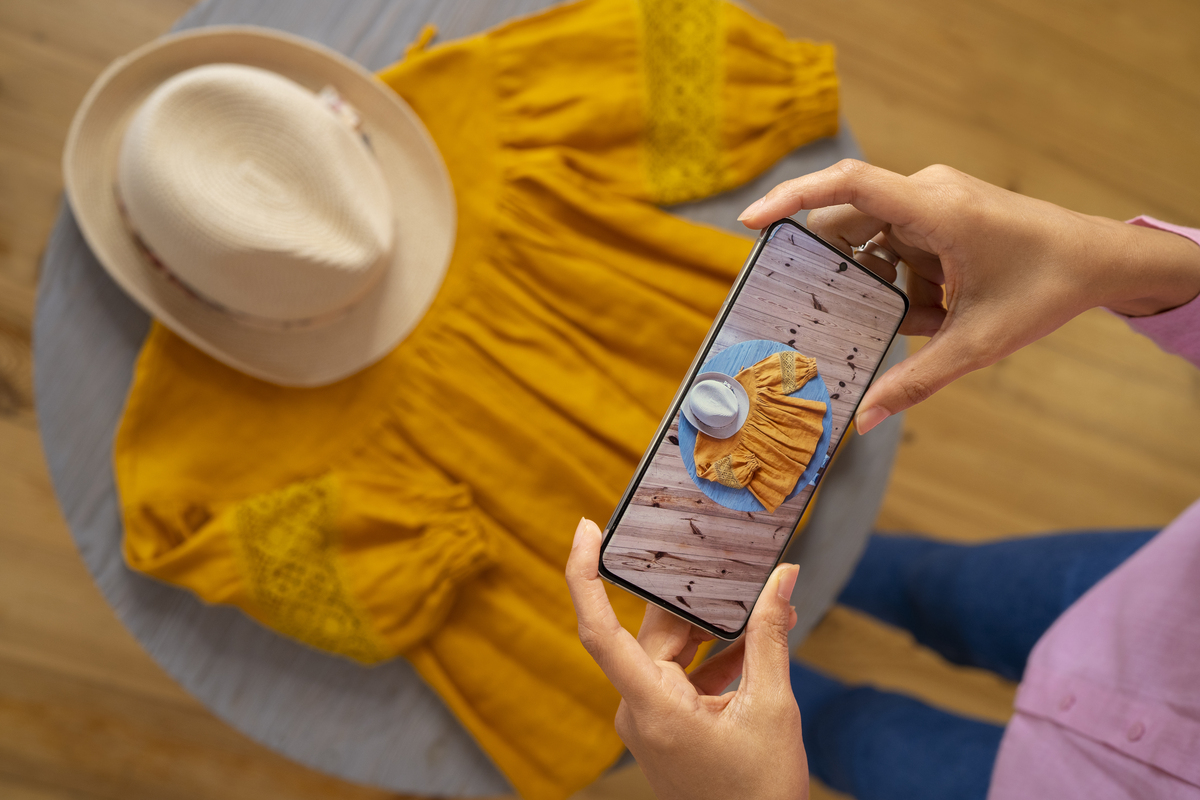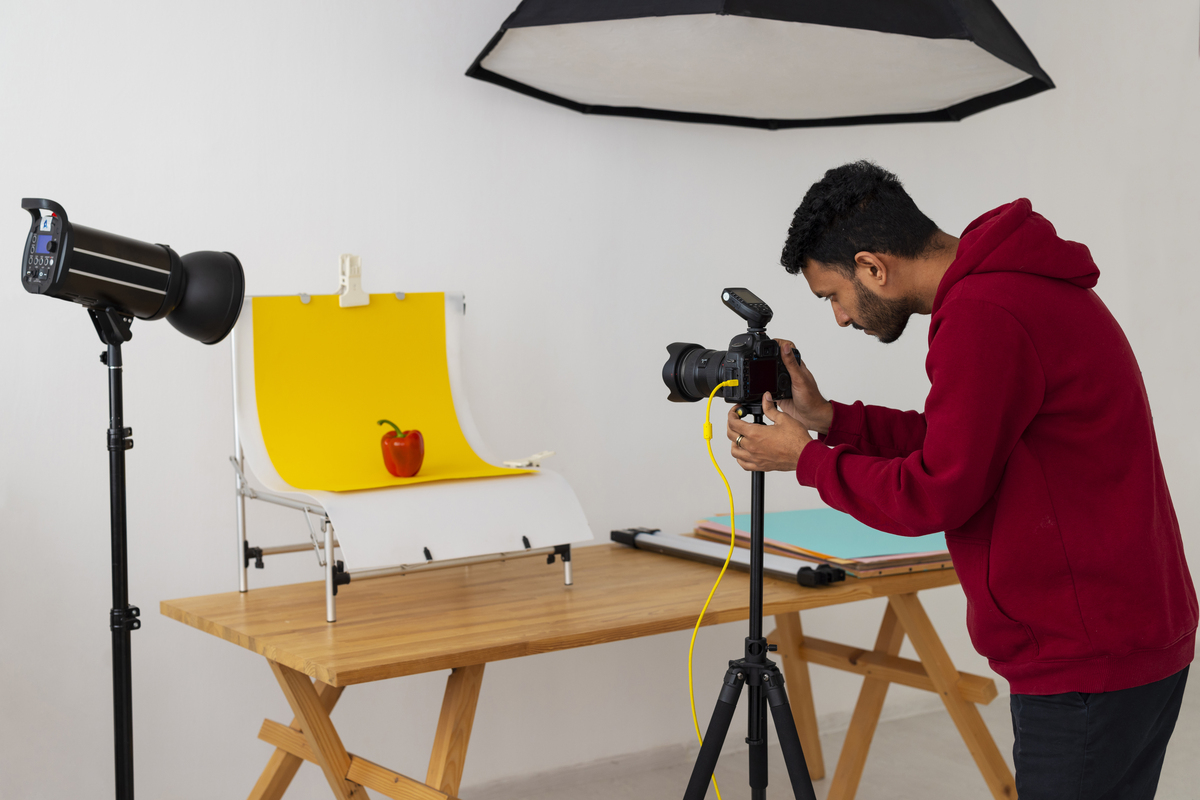
Product photos: High quality for more sales
Why are photos on your website so important?
This is how your products come to life thanks to photography: Why photos on your website are so importantPhotography is a crucial component in e-commerce: only a well-made online presence will bring you customers and thus ensure the survival of your business. In this regard, it is essential to use high-quality images. With the right kind of photos, you can highlight your products and create desire. After all, a picture is worth a thousand words. But that's not all: your products also benefit from professional photography. With appealing images, you can present them in the best light and show customers what they can expect from you. Good photos also make your company look more professional.
Product photos: Why quality is important
There is nothing worse than blurry or out-of-focus images in which important details are often unrecognizable. When it comes to marketing products, sharp and clear photos are a must. Why, you ask? Well, because they give customers an insight into the product and help them make the right buying decision.
Images play a crucial role throughout the customer acquisition process, from initial awareness to final purchase decision, increasing ROI every step of the way. They are a powerful tool to increase conversion rates, grab attention in the clutter of social media and clarify the product when it matters most. In addition, accurate visuals are crucial for reducing product returns, which heavily influence the e-commerce sector. They ensure that customers have a clear idea of the product, which is crucial given that 30% of online purchases are returned and 22% due to discrepancies between the product's appearance online and in reality. This can have a significant impact on profit margins, especially with free returns.
According to Google
-
Marketing campaigns with images have a 42% better CTR.
-
Facebook images convert 30% more than videos and 352% more than pure links.
-
53% of online shoppers say that images inspire them to buy.
Note these important questions
- Should you do the job yourself, hire a freelancer or use a specialized photography service, and what are your reasons for doing so?
- Determine the specific photography styles that fit your goals.
- Understand the concept of the "hero image" and decide if it is necessary for your goals.
- Decide on a lighting setup and the reasons for it.
- Plan your product display strategy: will the product be laid flat, hung or displayed on a mannequin and why did you choose this method?
Recognize bad product photography
- Low resolution, blurred or pixelated images.
- Poor lighting causing glare, shadows or an altered appearance.
- Inconsistent styling, different backgrounds and sizes.
- Colors that differ from the actual product and mislead the viewer.
- Random or awkward angles, cluttered or ill-considered composition.
- Lack of context that does not show the product in its intended environment or use.
- Restless or distracting images that draw attention away from the product.
- Lack of reference to size, leading to false customer expectations.
- Boring, uninteresting images that do not capture or maintain the customer's interest.
- Images that do not contain valuable product information.
Create good product photography
- High-resolution, clear images with lots of detail.
- Uniform, natural or studio lighting that emphasizes features.
- Consistent styling, background and size for a uniform appearance.
- True-to-life color reproduction.
- Carefully chosen angles and compositions to showcase the product.
- Products are shown in use or in appropriate surroundings to give context.
- Clean and simple images that focus on the product.
- Providing objects to scale or descriptive measurements for reference.
- Visually appealing images with a creative element to appeal to customers.
- The images convey information about the use, features and benefits of the product.
Making the right decision?
Photos taken by a professional or by yourself?
If you are a real photography talent and are sure that your pictures are appealing and present the product in the best possible way, then go for it! But if you're one of those people who can't keep their hands off the lens or simply have no idea about photography, it's better to leave it to a professional.

The advantages of professional photo production
Of course, the whole thing costs a little more than if you reach for your smartphone yourself. But remember: a good photo is worth its weight in gold! It can make the difference between a successful sale or a disappointing rejection. So think carefully about whether you'd rather save a few euros or invest in quality. After all, it's all about presenting your products in the best light, and that's only possible with professional photos.
What added value does a professional photographer offer?
An experienced photographer knows exactly how to present your product in the best light and which perspectives are most suitable. They work with high-quality equipment and have an eye for detail. Post-processing the photos also plays an important role. Colors can be adjusted or distracting elements removed to achieve the perfect result. All of this requires time and experience - things you may not have. After all, good images not only increase the sales success of your products, but also your image as a company in general. So if you really want to be successful on the market, you should definitely invest in quality - because it always pays off!

What are the advantages of taking product photos myself?
That's quickly answered: You save a lot of money. But think carefully about whether it's worth hiring a professional, because it usually pays off. If you have a good hand and talent, you can also achieve good results with photos you produce yourself. In this case, however, you should keep one important thing in mind. There are countless tutorials on youtube on how to improve your skills as a photographer. You should take the following tips to heart
What important things do you need?
-
The right equipment
The quality of the camera is fundamental, because it should be state-of-the-art. Whether it's a smartphone with a high-quality camera, a digital SLR or a classic Leica: camera, what matters most is whether and how you can use it. The device should already have a certain standard with corresponding setting options. In addition, the product to be photographed should be well illuminated; for this you need a light source. Finally, a tripod belongs to the "must-haves", so that you can adjust your camera exactly. By the way: you can also rent professional equipment in specialized shops.
-
The background
Another issue is the background in front of which the product to be photographed stands. Make sure it is clean and unobtrusive. A light, plain background is ideal for product photos and can easily be created with a piece of white paper or cardboard. Don't use a background that offers too much distraction and can put your product in shadow. This way, viewers can fully focus on your product. Likewise, you should make sure that the products are photographed at the right angle, in harmonious proportions - not too far up or down - so that all the details can be seen.
A tripod can be a smart investment for stability and consistency, particularly when photographing a series of items for an e-commerce site. It ensures sharp focus and uniform positioning across all photos.
When including models in product photography, ensure they resonate with the target demographic and do not overshadow the product. A model's natural appearance and appropriate expression are preferable to forced smiles, keeping the product at the forefront.
Creative angles should be employed judiciously, with straightforward shots often being the most effective for online stores. Overly creative positioning may result in inconsistency and confusion for customers.
-
The lighting
Lighting is not to be underestimated, because without the right lighting you will achieve mediocre results even with a first-class camera. It's best to go to the store and get advice on what kind of light source is right for your needs. Avoid direct sunlight or shaded areas in the room. If possible, use natural light from windows or ceiling lights. This light is softer than direct sunlight and will help you achieve better results.
-
Different perspectives
Different angles can help you showcase and understand products much better. Imagine seeing a photo of a new smartphone only from the front - you're missing half the information! What does it look like from behind? And how does it feel when you hold it in your hand? Skillful photography can show exactly these aspects and give the customer a much better understanding of the product. So take several shots from different perspectives and experiment around with them.
It's advised not to settle for a single picture. Providing 2-5 images per item significantly increases the chances of converting viewers into buyers, particularly for premium items where customer expectations for multiple images are higher. For handcrafted items, detail shots showcasing workmanship can add immense value, like a close-up of the hand-stitching on a crafted blouse or a potter's hands shaping clay on a wheel.
The varying angles, whether it be a front, back, or side perspective, or shots that show the product laid flat or on a model, enhance the consumer's understanding and appeal. It's reported that a third of consumers prefer to see more than one image per product. Thus, additional shots from different angles are worth the effort.
-
Image editing
Editing plays a crucial role in product photography, not as a place to cut corners financially. While retouching can refine an image, it can also degrade it if done excessively or poorly. Both under and over-editing can yield a disingenuous appearance that can turn customers away.
You have the option to edit the photos using photo editing software like Adobe Lightroom or Photoshop Elements - this will help you perfect every last detail! Simple editing techniques like adjusting brightness and contrast or color balancing can significantly improve the results. However, you can also enhance the photos with additional graphic elements like icons or text.
-
Text in the image
Product photos can be edited to provide additional information. For example, by adding text in the photo that points out special features of the product. For example, captions can be added to explain features or references to functionality. This is a clear added value for the customer, as it provides extra information. There are many options, but it's up to you to figure out which one works best! Example: the product photo of an accessory line for Dyson vacuum cleaners. The accessory parts are shown in a photo and named with their function.
-
Symbols and other graphic elements in the image
The same effect can be achieved by preparing the photo using graphic elements. For example, arrows can point out special features of the product or symbols can draw attention to special functions or care instructions. Example: On the product photo of an outdoor jacket, symbols for waterproofness, air permeability and references to the material (e.g. Gore-Tex) can be found again.

Here are some foundational steps for establishing a budget-friendly, do-it-yourself photography studio
Designing the ideal background
The background you choose can dramatically increase the focus of the product and simplify the editing process. You don't need expensive equipment; a white or light-colored background is often sufficient. The following options are possible:
Use a shooting table A white turntable is a worthwhile investment for multiple shoots and can be purchased online or homemade using white craft paper and a chair to create a seamless backdrop.
Accommodate larger items and A floor sweeper is needed for bulky products, which can be improvised with craft paper stretched from the wall to the floor.
-
Perfect product presentation
Positioning your product correctly is the key to a great photo. Make sure it is centered in front of the background on a flat surface. Use tools such as busts, mannequins or creative displays to showcase different aspects of your products.
-
Optimize the lighting
The lighting determines the quality of your photos. You essentially have two options:
Use natural light: Free and high-quality natural light is perfect for outdoor shots and photos with models, especially in the midday sun.
Use artificial light: For indoor shots or outside daylight hours, artificial light sources such as softboxes can provide controllable and even lighting.
-
The use of a tripod for more stability
A tripod is essential to ensure stability, especially if you are using a small aperture and a slow shutter speed to achieve a large depth of field.
-
Camera selection
Even though current smartphones are capable of taking high quality photos, a DSLR may be a better choice for frequent shooting as it allows more precise control over the shooting settings.
-
Multiple recordings and evaluation
Take several shots from different angles and distances. View them on the computer to get a better perspective and use software like Adobe Lightroom for organization and initial editing.
-
The basics of retouching
Post-processing is where good photos become great photos. Adjust the colors, remove distractions and optimize the lighting to get a consistent and polished series of product images.
-
Web optimization of images
Compress your images for use on the internet to increase the loading speed of the page without affecting the image quality. The correct naming and formatting of images is also important for search engine optimization and user-friendliness.
By following these modified instructions, you can set up a functioning DIY photo studio at home that is capable of producing professional-quality photos for your e-commerce website.
You decide to hire a specialist for product photography?
When you should choose a professional product photographer
It can be rewarding to take product photography into your own hands, but there are situations where the work of a professional can make all the difference. In addition to the quality of the equipment and the consistency of the editing, there are other reasons to hire a professional
-
Exceptional professional quality
The quality of photography is often directly related to the caliber of equipment used, such as cameras, lenses, lighting and editing software. Professionals bring their high-end equipment and expertise to ensure that your products are presented in the best possible way.
-
Guaranteed editorial consistency
A professional photographer will ensure a consistent look and feel to your product images, which is often difficult for amateurs to achieve. This consistency is crucial for brand identity and customer trust.
-
Efficient time management
When you outsource photography, you save valuable time that you can reinvest in your business. Professional photographers can work more efficiently and deliver a large quantity of finished images faster than you could do yourself.
-
Creative input and management
Professional photographers have a creative eye for your work. They can suggest styles, layouts and trends that you may not be familiar with, making your product presentation more dynamic.
-
Technical skills
Professional photographers have the technical skills to master difficult lighting situations, complex color corrections and other subtleties that can make or break a product photo.
-
Mastery of post-processing
A professional's work doesn't end with the click of the shutter. Their post-processing skills turn a good product photo into a great one by removing any blemishes and distractions that detract from the product's appeal.
-
Better conversion rates
High quality images are known to be more effective at converting visitors into buyers. A professional's ability to create stunning images can lead to a direct increase in sales.
-
Problem solving experience
When unexpected problems arise during a shoot, professionals have the experience to solve them on the spot. This ability to solve problems ensures that the shoot goes ahead and you get the pictures you need without any problems.
-
Higher perceived value
The perceived value of your products can increase through professional photography, as customers often associate the quality of the images with the quality of the products.
-
A new perspective
Bringing in a professional can give you a new perspective on how to present your products that will resonate with customers in ways you hadn't thought of.
-
SEO advantages
Professional images are not just about aesthetics; they can also be optimized for better search engine performance.
When you work with an experienced photographer, you ensure that every aspect of your product photography is handled with precision and care, ultimately emphasizing the professionalism and quality of your brand.
Product photos are an important investment in a business. They help to enhance your online presence and give customers a better understanding of your products. Undoubtedly, it is best to hire a professional photographer. However, you should have a clear idea of exactly what you want: create a brief so that the photographer knows what you expect.
After all, you shouldn't settle for mediocre pictures. Compare your work with the images of admired competitors and aim for that level of quality. Inferior photos can have an immediate impact on sales, while high-quality images can significantly improve the perception of a small business' greatness and reliability.
Investing in high-quality product photography pays off - as our satisfied customers can attest. We hope the following tips will not only highlight common mistakes, but also the hidden costs involved, and emphasize the value of professional product photos for a credible and substantial business presence.
